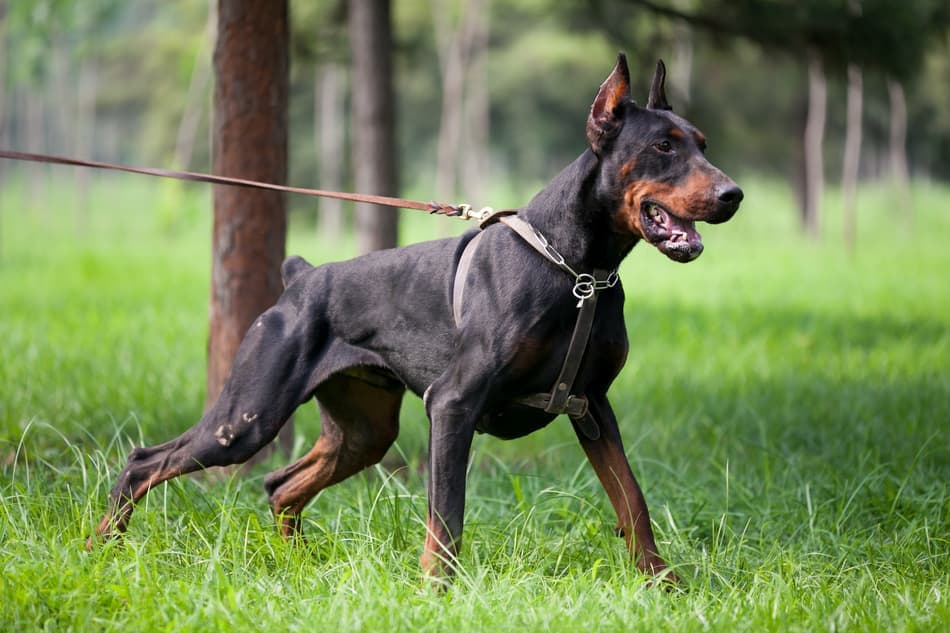
Whether it’s for participating in competitions or just for a healthy looking dog, many people express a desire for building muscle and increasing stamina in their Doberman. Well luckily for you, it’s not difficult to get a Doberman to build muscle, and your dog can even have a lot of fun doing it.
So how do you build muscle in a Doberman? The best way to build muscle in your Doberman is by providing a quality high-protein diet and finding an enjoyable resistance-based exercise. Activities that involve swimming, running on sand, or running uphill are all great ways to build muscle.
Doberman Pinschers are just all-around great looking dogs and a lot can be done to make them even better looking. And yes, I’m saying that a lot can certainly be done to make them more muscular or better defined through exercise and diet, up to a point.
It’s important to realize that genetically they’re built a bit more like marathon runners, and not like bodybuilders. They certainly can be muscular dogs, but only to a point. They’ll likely never be as muscular as a rottweiler or pitbull, it’s just not in their genetics. It’s important to keep that in mind while striving for a more muscular Dobie.
Additionally, there are two main types of Dobermans, the American and the European. The American variety is naturally a bit less muscular than the European variety.
Also, each individual dog will be genetically inclined towards a certain build. If you want a good idea of how your dog will look like as an adult, take a look at his or her parents. This will give you a general idea, but keep in mind that recessive genes can through a wrench in this, so what they’ll look like when they’re full grown is really impossible to exactly predict.
Safety First
Please Note: We are not veterinarians or canine nutritionists here at Doberman Planet, therefore the information presented here should not be considered professional advice. Learn more about this in our site’s terms and conditions.
It’s important to note that this article is not written for those looking to create an “ideal build” in their Doberman for participation in dog shows. That would be a completely different article. This article is for those looking to add a little muscle to their dog or increase their endurance for a happier, healthier dog overall.
Safety is the most important thing here since a dog owner who’s too eager to build muscle or endurance can do a lot of damage to their dog. So before you start, it’s important to see a qualified veterinarian and discuss your plans with them first.
Here are some general rules to keep in mind while exercising your dog:
- Don’t start too young. Before about 18 months to 2 years of age, the Doberman’s body is still developing. Bones and joints are not fully developed or strengthened. Too much exercise before about the age of two, especially high impact exercises on hard surfaces (or weight-bearing exercises), can cause permanent damage to your dog’s joints. Besides, Dobermans are naturally far lankier in their appearance at a young age than they will naturally be as an adult. This is especially true in male Dobermans who don’t completely “fill-out” until 2.5 to 3 years of age. So when in doubt, wait. They may just naturally develop the muscle you’re looking for anyway.
- Start slow. It’s always a great idea to start slow with your dog, slower than you might think. For example, if you want your dog to start carrying weight on hikes with you in a backpack, start with a completely empty backpack. After a few hikes with an empty pack, start adding very small amounts of weight. Starting slowly can avoid many injuries
- Always make it a positive experience. Exercising together is a great way to bond with your dog, as long as it’s a positive experience for both of you. Never make exercising a chore or a punishment. Doing so can be detrimental to your dog’s mental and physical state. Always give your dog plenty of praise while exercising and make it a fun experience. If your dog isn’t excited about doing the workout routine you’ve developed, then you’ve done something wrong.
- Pay close attention to your dog while working out. Learn to “read” your dog while he’s working out. You should be able to tell when he’s pushing himself too far or is in distress. Don’t ignore the subtle signs. Any sudden changes in a desire to do a certain workout, foaming from the mouth, excessive panting, favoring one leg over another, or whining, are all signs of trouble. When in doubt, stop the workout.
- Overheating is an issue in Dobermans. That sleek black (or other dark colored) coat is beautiful to look at but it absorbs more heat than you might think. Unfortunately, Dobermans do have issues with getting too hot. This goes back to the last rule about paying close attention to your dog. Always provide plenty of water and if you suspect your dog is getting too hot, stop and cool off in the shade or play in some water.
- Check the pads of the paws often. Make it a habit to check the pads of your dog’s paws before, during, and after your exercise routine. This is often the first place damage can occur and catching cracked or damage pads early on can help prevent much worse problems down the road.
In addition to some of these basic safety measures, it’s important to always allow plenty of recovery time. The way a dog’s body builds muscle is in a similar way to how a human builds muscle. As you work out, the muscle it breaks down. Then as the body rests and is well nourished, it rebuilds that muscle back up, stronger than before. This cycle of breaking down and rebuilding the muscle is what makes your Doberman bigger and stronger.
If you don’t provide adequate recovery time to your dog, their body will not have time to rebuild the muscle. Essentially the body will be breaking it back down again before it’s strengthened and in essence, you’ll be working against yourself. Provide at least two “off-days” spread out throughout the week where your dog gets to rest. Also try alternating workouts from one day to the next so that you aren’t doing the same workout twice in a row, providing the muscles time to strengthen.
Before You Start Exercising
Prior to starting any type of physical training for your dog, it’s important to get a good baseline of your dog’s current condition. There are also a few things you’ll want to do every day before you begin your training routine.
- Veterinarian Visit – See a veterinarian and get a basic physical performed on your dog. Advise the veterinarian of your intentions to start training. Give him or her a copy of the training schedule you’ll be starting, and get clearance from your vet to begin.
- “Before” Photos – Take photographs of your dog straight on (not from an angle) from the front, back, sides, and top in a well-lit area. This will be for comparison purposes later. Make note of the distance from your dog and the camera used to take the photographs so you can take comparison photos later in the same manner. Feel free to even take measurements if you want.
- Daily Checks – Before starting each day, check the paws and legs of your dog to make sure they appear uninhibited. Check the range of motion and that your dog is pain-free as you move their joints. Look for cracked, worn, swollen, or damage pads and make sure the dog’s nails are trimmed. Note any unusual behavior or appetite changes in your dog. If anything seems off, skip training that day and see your veterinarian.
One word of warning: If your dog wears a muzzle for any reason, especially the fabric type, make sure it’s removed before exercising. If left on it could be very dangerous. For more information on the proper use of muzzles, see my article Do Dobermans Need a Muzzle?
If you haven’t caught on yet, I want you to be extra cautious with your dog when beginning a training program like this. Especially for the first time, when your dog isn’t used to this kind of activity. One missed day of training isn’t going to set your dog bad hardly at all. If your dog needs a day off to relax, or to see a veterinarian because something seems unusual to you, don’t hesitate to do it.
Of course, it’s important to make sure your Doberman is leash trained before going much further. To see how to leash train a Doberman in a way they’ll respond to, see my article How to Train Your Doberman to Walk on a Leash
Increasing Endurance
Like with humans, increasing endurance in your Doberman requires consistent exercise. The best way I have found to approach this is to start with an activity that your dog naturally enjoys and build from there.
Most Dobermans will beg to go on a walk with their owner, at least my Doberman Cooper does. He also loves other activities like playing fetch with a tennis ball or chasing a frisbee. That’s why I formulated the workout routine below incorporating the activities my dog already really enjoyed.
Below is the schedule I did for my Doberman and it’s only presented as an example. Please keep in mind that this is not a plan that will work for every dog and every situation. It’s important that you tell your veterinarian what you plan to do prior to beginning a schedule such as this.
Naturally, you’ll want to modify the plan below to match your dog’s capabilities. Feel free to work off my plan below, modifying it to fit the needs of your specific dog. The most important part is to start slow.
Example Weekly Schedule
- Monday – Endurance Play Day
- Tuesday – Long Distance Walk/Run
- Wednesday – Rest Day
- Thursday – Endurance Play Day
- Friday – Long Distance Walk/Run
- Saturday – Rest Day
- Sunday – Fun Day
The idea of this schedule is to build up to the long-distance run or walk days and then have rest the very next day to allow the body time to recover. Before the next long distance run day, there is an endurance play day or a fun day as a way to build up to it. I found this schedule to be extremely effective in increasing the stamina and endurance in Cooper.
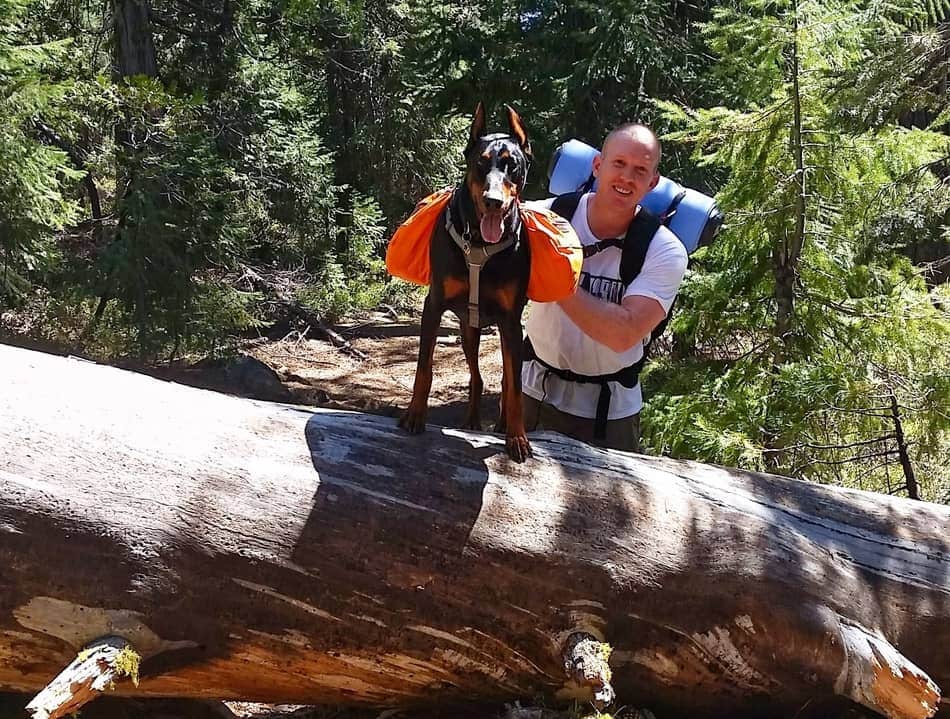
Building Muscle Mass
Just like with the endurance schedule above, I tried to find activities that my dog really enjoyed doing and build his schedule around that. Luckily my dog liked a little bit of everything, except agility training of any kind, he hated that. So we didn’t do any jumps or obstacles on our strength building play days, but he was up for everything else! Remember to modify things here to fit the needs of your dog and your situation.
The schedule I used for building muscle mass in my dog is similar in many ways to the endurance schedule in the previous section. The big difference here is that the focus is for the dog to perform at his or her best on the strength building play days.
Example Weekly Schedule
- Monday – Long Distance Walk/Run
- Tuesday – Strength Building Play Day
- Wednesday – Rest Day
- Thursday – Endurance Play Day
- Friday – Strength Building Play Day
- Saturday – Rest Day
- Sunday – Fun Day
That’s why there are two of these during the week. We are still trying to keep the dog well rounded which is why the other days are a mix of a long distance walk or run, endurance play day, and a fun day. But as you can see, there is always a rest day directly after the strength-building day to allow your Doberman’s muscles time to rebuild before more activity.
Activities for Each Type of Day
Below are what each type of day listed in the weekly schedules above generally consists of. Like everything else in this article, feel free to modify what I have done here to best fit your dog and your situation.
Long Distance Walk/Runs: If you are going for high levels of endurance, these are the most important days of the week. Even if you are trying to build muscle in your dog, these should be included somewhere your schedule, although less often than if you were training primarily for endurance. Only do one long-distance walk or run on these days.
For Cooper, we started with three-mile walks. Each time we’d go out for one of these long-distance days, we’d increase the distance we went between 5% and 10%. After we got to about six-mile-long walks, we started going on runs. I decided to start off with one-mile runs. He did this with ease and I found myself increasing the distance by 10% each time quite easily, at least initially.
NOTE: Dobermans are incredibly fast dogs with a very high top speed. Find out exactly how fast Doberman’s have been clocked running here.
At some point in this process, it was obvious that he was progressing far faster than I was, and I began to ride a bicycle next to him while he ran alongside me. This allowed me to work him out in a way where he wasn’t held back by my limitations. Even after we started going on runs instead of walks, we would always warm up and cool down by walking.
One thing I should mention; it’s very important to bring a basic dog first aid kit with you if you are going on long hikes (or runs), far from home. If your dog damages the pad of their paw 6 miles away from home, you’re going to potentially be in a lot of trouble. I recommended a great pet first aid kit in the Best Walking and Hiking Gear section of my Recommended Products page.
Endurance Play Days: On these days I would usually take Cooper to the park twice (once in the morning and once in the evening), and he knew that we were there to work. I would usually start with some short throws of the Chuck-It ball to warm up, and work up to some long distance tosses in rapid succession. Sometimes we’d work with a frisbee during this time or I would do sprints while he chased me. The goal of endurance play days is to keep your dog’s heart rate up the whole time by keeping him active and without worrying about adding resistance. I compiled a list of some of my favorite throwable toys that also hold up really well here.
I would time how long we were doing this high-intensity activity, write it down, and increase it slightly each day out. I started with only about 10 minutes of high-intensity work and increased it by about 2 minutes each trip out. When I felt like he was getting near the end of what I could reasonably expect him to do in a day, I would only increase it by about a minute each time.
“Always provide your dog with plenty of water and stop training if anything seems unusual.”
– John Walter (DobermanPlanet.com)
Strength Building Play Days: On strength-building play days, I would pick a strength-building exercise and do it once that day. The idea here is to provide your dog with some resistance in whatever they’re doing. Have them focus on short bursts of energy and power.
There are many fun ways to do this. You could have your dog run up hills, run in the sand, or even better, run uphill in sand. Swimming or agility training are also great ways to do this. To learn more about swimming with your Doberman, see my article Swimming Dobermans: Getting Your Doberman to Love Swimming.
For agility training, set up small jumps or other obstacles for your dog and make it a game for them to jump over these obstacles you’ve set up to get a high-protein treat at the end. Dobermans are very trainable and will catch on quickly to what you want them to do.
Another option for the strength building play days is to do some weighted hikes with your dog. Get a good quality (not a cheap) backpack for your dog, like the one I recommended in the Best Walking and Hiking Gear for Dobermans page. Start with an empty backpack for the first few hikes so that your dog gets used to having it on their back, then slowly add a little weight each time you go out. Most Dobermans can handle up to 20% of their weight without an issue. I wouldn’t go beyond 30% at the absolute maximum though, and only after a long time of slowly working up to it. Make sure you watch how the pack fits and that it isn’t causing any irritation or rubbing on your dog’s skin.
Fun Days: This day is just what it sounds like, it’s a day filled with a lot of fun! I still attempted to tire out my dog on “fun days”, but it wasn’t as intense and I didn’t time it. We would usually go to the local dog park and I’d let the other dogs run him ragged. Sometimes I would bring him to see family and let the kids run around with him all day long in the back yard. We also enjoyed swimming on our fun days. The point on these days is to get some mixed forms of exercise while having fun and allowing it to be a little less regimented.
MORE ACTIVITY IDEAS: If you want a list of some of the all-time best activities to do with a Doberman to keep them fit and healthy, see my Doberman Activity Guide here for tons of great ideas.
Rest Days: These days are very important. Rest days allow your dog’s muscles time to rebuild. These were fairly relaxed days for us but we would still often go for a slow and leisurely evening stroll from time to time.
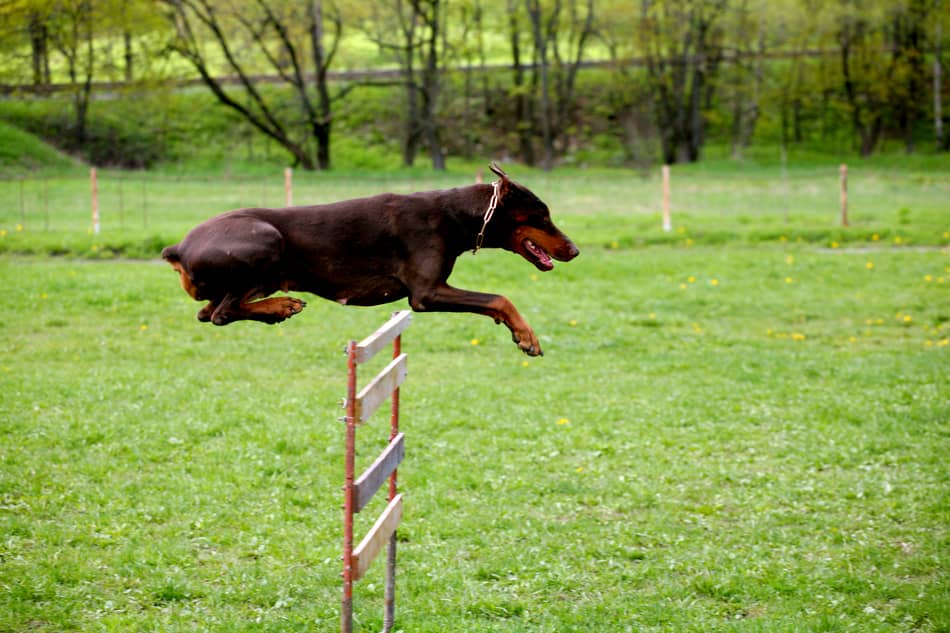
Tone and Definition
You really shouldn’t worry too much about tone and definition with Dobermans. Luckily, these dogs already have very low body fat naturally. In fact, this is true almost to a fault, hence why they hate the cold so much.
You should see muscle definition increase naturally as your dog gets stronger. If you are focusing on building muscle and power in your Doberman and feel you want a bit more focus on definition, consider replacing the fun day with another long distance walk or run day in the schedule. But I would only do this after a few months (minimum) of work with the muscle building schedule, and only after seeing progress. Again, this really isn’t necessary at all for most Dobermans.
Tracking Progress for Best Results
It’s not only very important to track your dog’s progress, but it’s also highly motivating to you to see how your dog has improved in black and white. One way is to keep a log and write down things like how far your dog walked today or how many minutes of activity they got. Then you have a benchmark to improve upon next time out with your dog.
However, this is fairly difficult and really doesn’t give you all the information you need. The best way is to use a smart collar for your dog which connects to your cell phone to give you very accurate, and very detailed reporting of your dog’s activity levels.
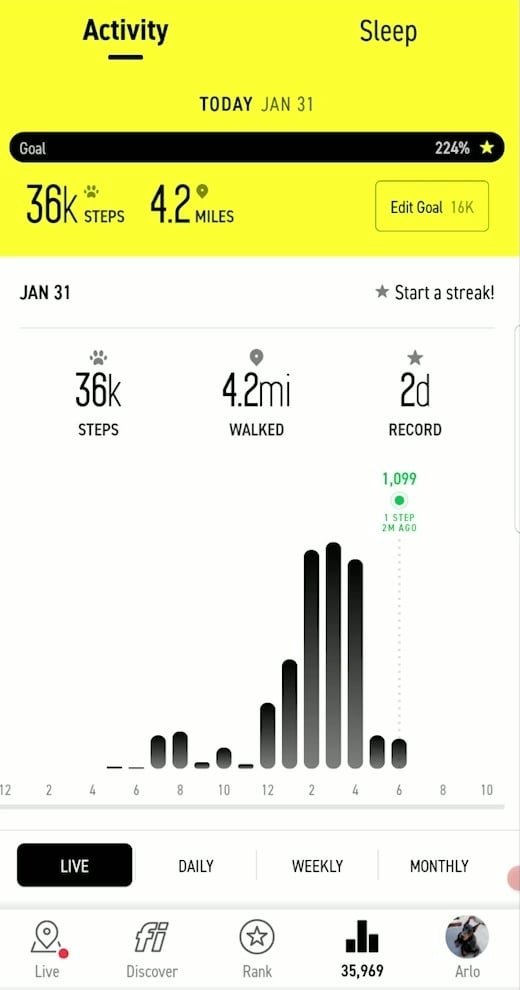
I use the Fi Smart Collar. It’s a GPS collar for your dog that tracks things like daily steps, distance traveled, sleep time, and so much more. It graphs everything from day to day, week to week, and so on. There are even leader boards for Dobermans so you can compete against friend’s dogs, all other Dobermans in the Fi network, other dogs in your state, and even all other dogs in your city.
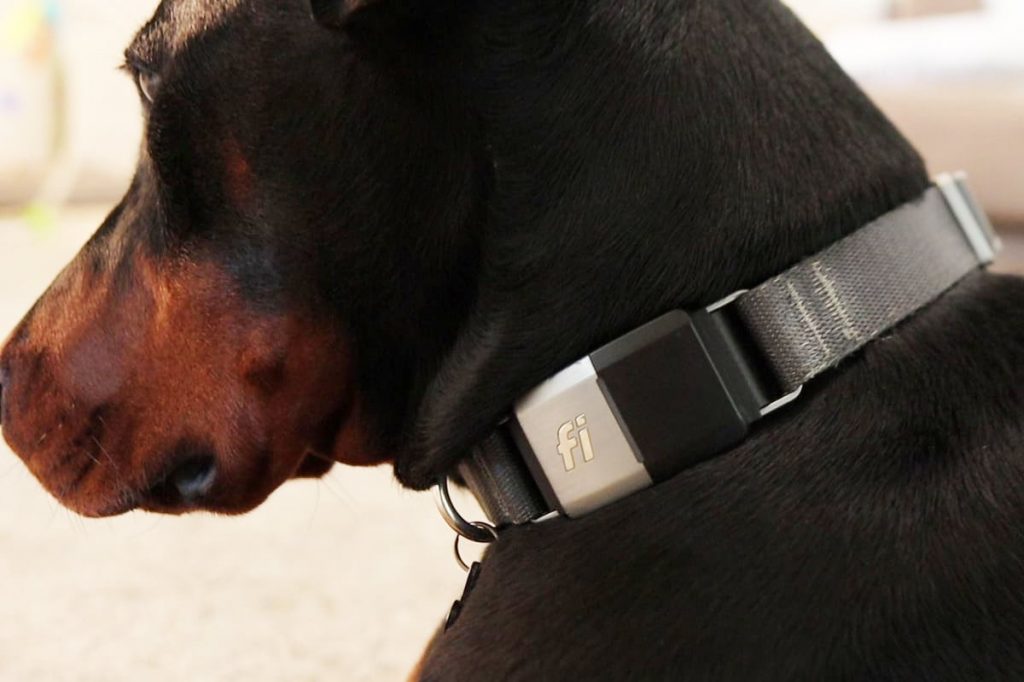
It’s also waterproof, dustproof, and incredibly tough (it’s made out of brushed metal and is rated at 300lbs of pull resistance). The battery life also is lightyears beyond the competitors and can last up to 3 months on a single charge. It has virtual fences to alert you when your dog leaves a certain area and so much more. Really too many features to go into here. The best thing is it’s highly motivating and an invaluable reporting tool for exercising your Doberman, check out the Fi Smart Collar here.
Food
Make sure to give your Doberman a quality dog food that is high in protein. I did an in-depth analysis of some of the best foods to feed your Doberman here. Refueling is important, this is not where you want to cheap out.
- Endurance Training: If you’re primarily doing endurance training with your Doberman, feed them a quality dog food at least twice during the day. Slowly increase the amount of food you feed your dog as activity levels increase.
- Muscle Building: If you are focused mainly on building muscle mass in your Doberman, feed them quality food three times a day. Try to time it so that the second meal is within about an hour after the day’s workout. Make sure this is a high protein (within reason) diet. If you need to add a bit of protein, try adding some shredded chicken to their normal food or just rewarding them through the day with a quality high protein treat.
This is just the basics of food and dietary requirements for your dog while training. There is a lot more to this topic. Many people swear by multi-vitamins or even workout enhancing supplements for dogs. If you want to start using multi-vitamins or other supplements, please talk to your veterinarian first. You are (probably) not a vet, and you should not be dosing your dog with these things without first seeing one.
Many owners swear by feeding their Doberman a raw diet containing plenty of raw meat for an increase in energy and building leaner muscle. To see if that might be right for you, take a look at my article Should You Be Feeding Your Doberman Raw Meat?
TIP:
If you’re short on time in the day and need to work your dog a little longer while you get a few things done, consider getting an automatic ball thrower like the one I listed here. You can set the timer for 15 minutes and walk away while it tosses the ball over and over. It’s a great way to tire your dog out just a little more at the end of the day while you get a few things done.
Final Thoughts
Dobermans are naturally very muscular dogs with great muscle tone and definition. In fact, these dogs will naturally get more muscular and “fill-out” in the first few years of life without any kind of training what so ever.
Even so, some people want to train their dogs a bit further. If you are one of them, just be reasonable about it and always involve your local veterinarian in your plans. Remember, a dog can’t tell you when something hurts or doesn’t feel right, so you need to proceed with extreme caution. Please keep it a fun experience for both you and your beloved Doberman, and you two will likely bond even closer through the experience.
Related Questions
At what age does muscle naturally develop in a Doberman? Female Dobermans generally continue to naturally add muscle mass until about the age of two. Male Dobermans may continue to fill out until about three years of age.
How do you build muscle in a Doberman’s chest? A combination of resistance-based training that focuses on the front legs and a quality diet is necessary for building muscle in the chest area of a Doberman. Swimming is one example of an activity that can help build up the chest area.
What exercises help to build muscle in a Doberman? Running up hills, running in sand, swimming, and agility training are all examples of great

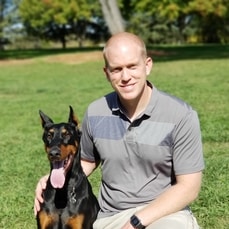

I’m hoping to get a Doberman in the future but I don’t have a fenced-in yard any ideas or suggestions that you have that might help? Thank you!
Most people without a fenced-in yard will start by building some sort of dog run. But in general, these dogs love being inside with their owners anyway so hopefully, it won’t be too much of an issue. Wireless fences are also an option for an extra layer of protection if keeping them in your yard is a major safety concern. However, those aren’t without their flaws also and many people don’t like the thought of those. Check the tech section of my recommended products page in the menu, they also now have pet GPS trackers which are nice for more peace of mind.
Hello John,is my 1,500 square meters lawn area and yard enough as a exercise space for my two dobermanns? Thanks a lot
I’ve I’m doing my conversions correctly, that should be about 1/3 acre. If that’s the case, then yes, that’s plenty of room!
Very nice article. Thanks.
I’m so glad you found it helpful!
Thanks for taking your time to share with me.
In a short two weeks I get my red headed boy.
Congrats! That’s great! Keep us updated on how it goes!